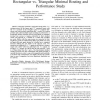Free Online Productivity Tools
i2Speak
i2Symbol
i2OCR
iTex2Img
iWeb2Print
iWeb2Shot
i2Type
iPdf2Split
iPdf2Merge
i2Bopomofo
i2Arabic
i2Style
i2Image
i2PDF
iLatex2Rtf
Sci2ools
JCA
2016
2016
Rectangular vs. Triangular Minimal Routing and Performance Study
—This paper presents a comparative study of the XY – routing protocol in the square grid “S” examined herein with the XY Z protocol in the triangular grid “T” examined elsewhere, both with toroidal connections and N nodes. The routing problem (also called multiple target searching) is performed in a partitioned cellular automata network with agents (or messages) moving from sources to targets, preferably on their minimal routes. The network in S consists of N nodes with 4 buffers per node. Buffers with the same names are connected to their neighboring nodes via unidirectional links. Each buffer may host an agent and each agent situated in a buffer has a computed direction defining the new buffer in the adjacent node. Two scenarios are examined: (i) N −1 agents are moving to a common target (also called “all-to-one gathering”) (ii) N/2 agents are moving to N/2 targets. It is shown that in both cases the T grid
Algorithms | JCA 2016 |
| Added | 06 Apr 2016 |
| Updated | 06 Apr 2016 |
| Type | Journal |
| Year | 2016 |
| Where | JCA |
| Authors | Dominique Désérable, Rolf Hoffmann |
Comments (0)

